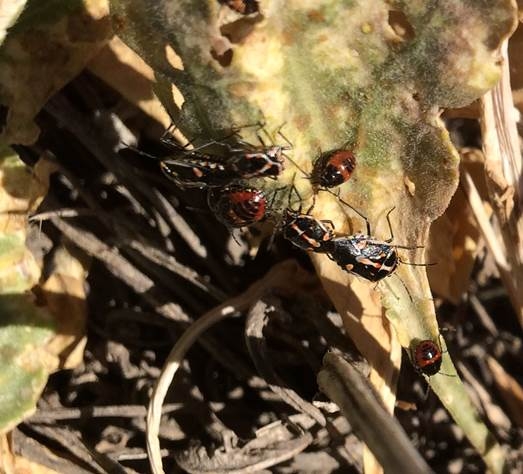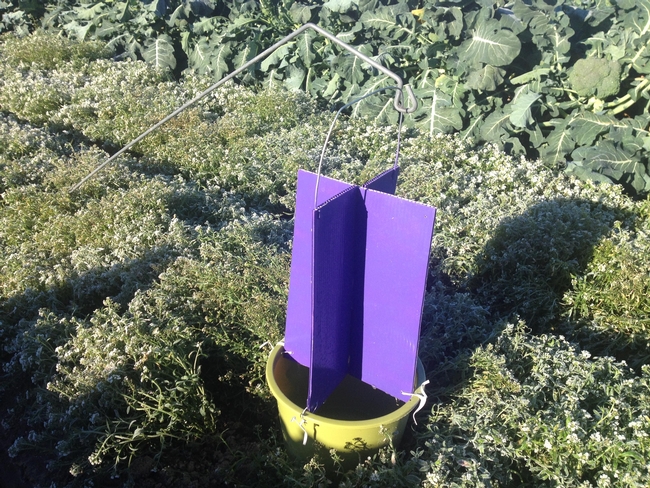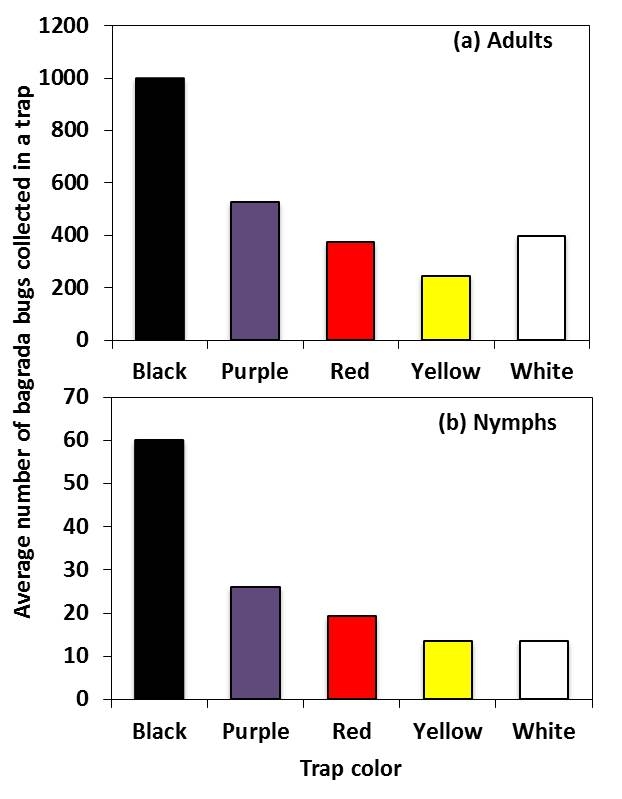Bagrada bug (Bagrada hilaris) (Figure 1), an invasive stink bug species native to old world countries of southern Africa, Middle East and Asia, was first detected in North America from Los Angeles Co, California in 2008, and is now established in brassica crop production regions of central coast of California.
Bagrada bug prefers cruciferous hosts (Family: Brassicaceae) including broccoli, cauliflower, cabbage, kale, arugula, or collards. Also, bagrada bug could survive on cruciferous weeds such wild radish, London rocket, short pod mustard, and shepherd's purse, as well as the insectary plant, sweet alyssum. Mustard weed species are very common in ditches, roadsides, and along the edges of agricultural fields in the central coast of California. Mustard cover crops such as white mustard and Indian mustard in particular, could harbor bagrada bug populations, which are not often monitored for insect pests.
Damage to brassica crops varies but can be severe. Severe economic loss has been reported when injury occurred during early developmental stages of the crop such as cotyledon or < 4 leaves stages. Injury on leaves appears initially as small puncture marks, which turn into white patches as leaves expand. In broccoli and cauliflower, the economic injury occurs when the bug feeding kills the apical meristematic tissue of young seedling, which later results in “multiple heads” or sometimes “blind head” (without a head). Severe feeding also depletes the nutrient reserves of the plant leading to desiccation or wilting. Other leafy brassica crops such as mizuna mustard or arugula are especially at risk from direct feeding damage of bagrada bug.
At this time, no baseline information on bagrada bug abundance, seasonal activity, or generations has been established in the coastal brassica crop production regions in California. Limited information exists to determine threshold based pest management decisions for bagrada bug. Monitoringfor bagrada bug during mid-day hours might increase the probability of finding them as the bugs typically hide and stay in the cracks and crevices or on the underside of leaves when the temperature is cooler. Strong attraction to specific color could be utilized when developing selective traps for monitoring bagrada bug in the field. Yellow traps are most commonly used for monitoring true bugs such as false chinch bugs, plant bugs, psyllids or stinkbugs. Yellow pyramid traps were used to monitor brown and dusky stink bugs.
This study was conducted to determine the influence of trap color on catches of bagrada bug. In fall 2013, an organically-managed broccoli field in San Ardo, CA was chosen for the study. Planting sweet alyssum is a common practice among organic growers in the Salinas Valley to harbor beneficial insects such as syrphid flies (hover flies) and lady beetles within the cole crop field. Strips of sweet alyssum were planted within the broccoli field. Cross-vane traps were constructed using corrugated plastic sheets and were painted with white, yellow, red, purple, or black paint (Figure 2). All the trap-base containers used in this study were light green colored. Traps were placed within the sweet alyssum plants (Figure 3).Bug captures were recorded for up to 5 weeks.
In total, 10,654 bagrada bug were captured and were predominantly adults (95%). Adult bagrada bug captures were influenced by trap color (Figure 4a). Black traps captured almost twice the number of adult bagrada bug than purple traps; however, adult catches were similar among purple, white or red traps. Catches of adults were higher in purple than in yellow traps. Similarly, the numbers of bagrada bug nymphs collected among various colored-traps were higher in black traps than other colored traps (Figure 4b). Future research will investigate the potential use of color preference with plant host odor to develop traps for field monitoring of bagrada bug
For those of you, who are interested to read more on it, please find the published article after clicking the link (below) and feel free to contact me (Shimat Joseph) at svjoseph@ucanr.edu or 831 759 7359.
http://cemonterey.ucanr.edu/files/195965.pdf



